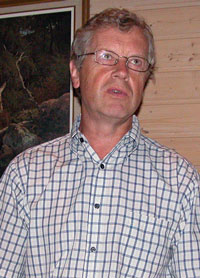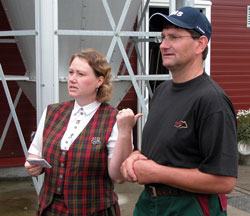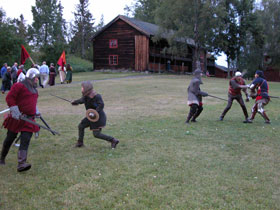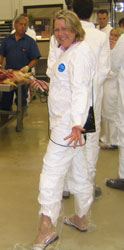 Pigs are dying. The question is why?
Pigs are dying. The question is why?
Is it simply the presence of PCV2, which is found in virtually every swine herd worldwide?
Or is it the co-factors? PRRS? Mycoplasma? Salmonella? What is their motive?

That is what the Boehringer Ingelheim Vetmedica Inc. (BIVI) project known as MAGIC – or Monitoring Assignment for a Global Insight into Circovirus associated diseases – is trying to find out. Much like the popular TV show which celebrates the skills of crime scene investigators, researchers are digging deep and looking at every possible factor to determine what is causing what they are calling PCVAD, Porcine Circovirus Associated Diseases, characterized by progressive weight loss, lesions, infections and elevated mortality in mainly early finishing pigs.

In the picture taken at the BIVI PCVAD update meeting last week, Dr. Ken Schwartz of Iowa State University posts a recently deceased pig that might have had PCVAD and demonstrates the proper way to take all the necessary tissue samples for the MAGIC project. Samples are placed in carefully labeled bags and jars to be sent to the lab for study.
Here’s a 4:00 interview with Klaas Okkinga, BIVI swine marketing manager, with more about PCVAD and MAGIC.  Klaas Okkinga.
Klaas Okkinga.
 One of the companies helping sponsor the IFAJ Congress here in Norway is GENO Breeding and A.I. Association.
One of the companies helping sponsor the IFAJ Congress here in Norway is GENO Breeding and A.I. Association. Torstein Steine Interview (4 min MP3)
Torstein Steine Interview (4 min MP3)

 Before we got to go into the dairy barn on today’s IFAJ Congress tour we learned about automatic or robotic milking from the expert.
Before we got to go into the dairy barn on today’s IFAJ Congress tour we learned about automatic or robotic milking from the expert. Today I got to visit a dairy operation which is pretty big business in Norway. We toured the Smestad farm. Pictured here are our hosts, Ole Kristian and Randi Skallerud.
Today I got to visit a dairy operation which is pretty big business in Norway. We toured the Smestad farm. Pictured here are our hosts, Ole Kristian and Randi Skallerud.
 I have to interrupt my coverage of the IFAJ Congress since this is a big story that just came to my inbox via news release. It looks like
I have to interrupt my coverage of the IFAJ Congress since this is a big story that just came to my inbox via news release. It looks like  I left the dinner last night a lot earlier than most. Just as I was leaving to be a good boy and go home to my hotel room a seed spitting contest was getting started.
I left the dinner last night a lot earlier than most. Just as I was leaving to be a good boy and go home to my hotel room a seed spitting contest was getting started. Here at the IFAJ Congress in Norway we have not gone hungry.
Here at the IFAJ Congress in Norway we have not gone hungry. Before our dinner last night we got to see what I think vikings like to do. And that is fight.
Before our dinner last night we got to see what I think vikings like to do. And that is fight. Our second evening in Hamar, Norway at the IFAJ Congress was a mix of very good cultural entertainment and local food and beverage.
Our second evening in Hamar, Norway at the IFAJ Congress was a mix of very good cultural entertainment and local food and beverage. I had to pose for a picture in the ISU wet lab during the
I had to pose for a picture in the ISU wet lab during the 
 Pigs are dying. The question is why?
Pigs are dying. The question is why?